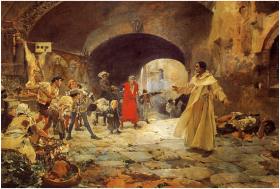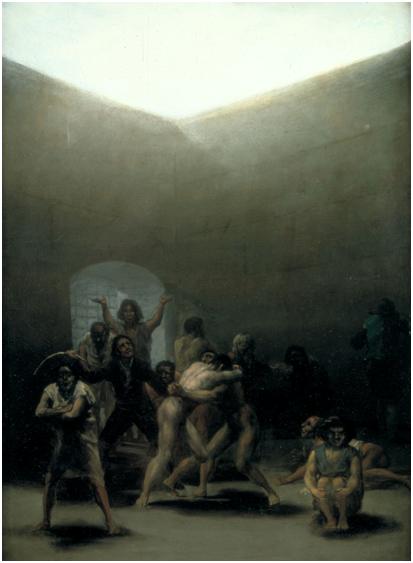
In 1816, French physician Jean-Étienne-Dominique Esquirol began his extensive contribution on madness for an important Dictionary of medical sciences with the following observation: “How many meditations are offered to the philosopher who, separating himself from the tumult of the world, traverses an asylum for the insane! There you will find the same ideas, the same mistakes, the same passions, the same misfortunes: everything is like in the world itself. But in an asylum, the features are stronger, the shades more marked, the colours brighter, the effects clearer, because the man shows himself in all his nakedness, because he does not hide his thoughts, because he does not hide his imperfections, because he does not provide his passions with the seductive charm, or his vices with the deceiving appearance”. This fragment, derived from the pen of one of the most active and charismatic pioneers of mental medicine, is a particularly suggestive proof of the fascination that the spaces of madness throughout history have exerted. In fact, it is no coincidence that mid-European travellers from the eighteenth century popularised the passage of lunatics through hospitals and departments as an important stage of their Bildungsreisen or training tours.
Facing the interpretation of the French philosopher Michel Foucault, for whom this contemplation of confined madness or the attendance at religious pilgrimages, parades and theatrical spectacles interpreted by madmen symbolised their (modern) conversion “in something to look at, [in which] the monster that lives in the bottom of oneself is not seen”, the demented establishments, for many illustrated visitors, were a privileged place to widen their knowledge and – as Esquirol pointed out – to familiarise themselves with the most vulnerable, intimate or nocturnal side of human nature. In this sense, we must remember, for example, the case of Francisco de Goya, who in 1794 painted a sinister Corral de Locos (‘madmen corral’) after having witnessed numerous scenes of abuse of inmates in Zaragoza in the famous Nuestra Señora de Gracia Hospital; significantly, from that moment madness had a repeated presence in his production, embodied in figures that evoke a shady and twilight vision of the human condition and directly appeal to the observer’s own irrationality.
In the case of the city of Valencia, the passage and the more or less morbid or peculiar visits of the public to the spaces of madness are documented from the appearance, in the fifteenth century, of the first institutional device that specifically assumed the fostering and safekeeping of crazy people. As everyone knows, this institution was founded in 1409 as the “Hospital de Innocents, Folls e Orats” (‘Hospital for the Innocent, Crazy and Lunatic’) with the support of a dozen “citizen merchants” and the initiative of the Mercedarian friar Joan Gilabert Jofré, of whom the tradition tells that delivered a sensible homily at the cathedral in which he suggested the creation of a space to collect the “poor innocent and furious who wander this city”. The building was authorised by a privilege of Martí l’Humà and begun to be built in 1410 on land located on the edge of the old Portal de Torrent of the Christian wall. A century later (1512), the hospital was absorbed by the new General Hospital of Valencia, to which the following year king Ferdinand the Catholic extended the privileges granted by the monarchs previous to the House of Fools. It should be pointed out that, according to the characteristics of other medieval foundations and against a widespread anachronism, this Hospital of Innocents was not at any time an institution specialised in medical care (and much less in psychiatric care) but a place to practice the Christian virtue of hospitalitas with the crazy people (“innocent and furious”) and to fulfil a double function of protection of the weak ones and of defence of the public order. It is also very likely that Jofré, who had traveled as a redeemer of prisoners in North Africa on several occasions, knew the existence of similar institutions in the Islamic world and would be directly inspired by some of them.
French Hispanist Hélène Tropé has given us a detailed description of how the hospital worked throughout its first centuries of history. With an occupation that ranged between fifty and one hundred inmates of both sexes (among which, from 1493, the fostering of beggars and “non-demented people” was authorised), crazy people were housed in collective dormitories or isolation cages (in the case of the furious), they were dressed in a modest and uniform way (or clashing and colourful in their sporadic outings in the city to participate in collections, processions or celebrations), they were commended to collaborate in spinning, cleaning and other domestic tasks (in accordance with the condemnation of the idleness, the repression of the begging and the new value granted to work from the sixteenth century), and were visited in a timely manner by the institution’s leading doctors (among them there were very prominent figures of Valencian science and culture such as Bartomeu Martí, Jaume Roig and Lluís Alcanyís). Seguint els preceptes clàssics d’Hipòcrates i Galè, els facultatius concebien la bogeria com un desequilibri humoral que afectava les facultats rectores del cervell, de manera que els seus tractaments es basaven en la intervenció sobre les anomenades coses no naturals (fonamentalment, l’alimentació) i en l’administració de purgants com l’agàric blanc, el ruibarbre o l’el·lèbor (especialment indicat per als malenconiosos) i sedants com la càmfora, el cascall o el xarop d’absenta (àmpliament utilitzat com a somnífer). In accordance with the classic precepts of Hippocrates and Galen, the practitioners conceived madness as a humoral imbalance that affected the governing faculties of the brain, so that their treatments were based on the intervention on so-called non-natural things (essentially feeding) and in the administration of purgatives such as white agaric, rhubarb or elbor (especially indicated for the melancholic) and sedatives such as camphor, poppy or absinthe syrup (widely used as sleep-inducing aid).
Despite the founding, throughout the fifteenth century, of similar institutions in cities such as Barcelona, Zaragoza, Seville, Valladolid, Palma or Toledo, the Hospital for the Innocent became an emblematic space of the new place reserved for madness in the post-medieval society, to the point that Lope de Vega took advantage of his reputation for setting a popular comedy there: “Valencia has – says Valerio, one of its characters – a famous hospital, where the frantic ones are cured with great care and careful vigilance”. Over time, this initial prestige significantly decreased due to the disinterest of doctors and administrators, the lack of investments and some unfortunate incidents such as the fire that destroyed a large part of its dependencies in 1610, so that the house (and later department) of madmen entered a long period of decline, from which it practically never recovered. In fact, the emergence in the transition from the eighteenth to the nineteenth century of the new mental medicine of the alienist, of the therapeutic called “moral” of madness and modern asylums had no appreciable consequences in the institution. There were, indeed, some isolated attempts to introduce reforms such as the one between 1848 and 1893 performed by Dr. Juan Bautista Perales, who denounced the abuse of coercive measures, began to examine in detail the medical history of the inmates, endeavoured to refine the diagnostic categories and do some modest trials with the treatments recommended by the great French specialists. But the general tone continued to be dominated by the absolute impropriety of facilities, overcrowding (mid-nineteenth century there was an average of two hundred hospitalised men and about a hundred women) and a widespread lack of resources.
Things did not improve much when, in 1866, the section moved to reside in the former confiscated convent of Santa Maria de Jesús, acquired by the Provincial Council of Valencia, and received the name of Provincial Psychiatric Sanatorium of Father Jofré. Visited a few years later by the American doctor, Edward C. Seguin, the new hospital (which already had more than five hundred hospitalised people) he had the impression it was an indignant redoubt in which violence, abandonment and the absence of any therapeutic approach prevailed, to the point that he declared “a stain on the beautiful name of Spain and a surviving example of the cruelty of the Middle Ages within modern humanitarianism”. Along the same lines, and with great impact, Madrid psychiatrist Gonzalo Rodríguez Lafora published, in 1916, in the reformist newspaper España some creepy photographs of what seemed to be a regular practice in the institution and in which two almost naked inmates with an iron belt and chained feet and hands were shown.
More than half a century later, the situation had not excessively changed despite the introduction of new therapeutic methods (shock treatments, psycho-drugs, etc.) and the widespread improvement in the standard of living experienced by the country. Thus, in 1972, the Sabado Gráfico weekly newspaper caused a new media scandal with the publication of a shaking report describing the terrible conditions in which the nearly 1,500 inmates of the asylum scraped out a living and the repeated escape attempts that the institution suffered was nothing other than “an obvious sign of mental health”. In those circumstances, the provincial authorities of late-Francoism, advised by the technocrats of the regime and with the intention of recovering the old prestige of the pioneering work of Fr. Jofré, conceived the megalomaniac and untimely project to build a “Psychiatric Sanitary City” on land located in Bétera. Operational from 1974 – although Jesus remained open as gerontopsychiatric residence until his definitive closure in 1989 –, the new hospital was not at the heart of the controversy until its dissolution (after less than two decades of operation) due to administrative negligence, labour disputes, the hostile attitude of adjacent populations and, above all, the poor design of a device that, as the psychiatrist Cándido Polo had mentioned first-hand, had been proposed to overcome the former asylum order with a new isolated asylum structure, oversized and far from the community.
The Bétera predictable failure did not surprise anyone at a time when psychiatric practices aimed to definitively break the vicious circle of illness and exclusion they had caused in the past. After the approval of the General Health Law in 1986, Spain finally joined the deinstitutionalisation, psychosocial intervention and community service trend that other countries and international organisations tried to impose since the mid-twentieth century with the creation of psychiatric units in the general hospitals, ambulatory mental health centres and several rehabilitation, occupational and residential intermediate resources. However, the intrinsic weakness of inclusive state policies – and, very particularly, at the autonomic ones – has led to a current scenario of precariousness that, to a large extent, keeps reproducing the worst vices of old asylums, at least concerning the situation of people who require a greater degree of accompaniment and support. And, thus, the dispersion and neoliberal dilution of the spaces of madness has generated the fiction of a postpanoptic invisibility that daily experience, the universal vocation of foolishness and the numerous inadequacies of a progressively aseptic and technified management are in charge to deny at every moment.
To know more:
De Vega y Carpio, Lope (2003), Los locos de Valencia. Madrid, Castalia (original from 1620).
Polo, Cándido (1999), Crónica del manicomio. Prensa, locura y sociedad. Madrid, Asociación Española de Neuropsiquiatría.
Tropé, Hélène (1994), Locura y sociedad en la Valencia de los siglos XV a XVII. Valencia, Diputació de València.
Personatges i espais de ciència (‘Science characters and spaces’) is a project of the Unit of Scientific Culture and Innovation of the University of Valencia, with the collaboration of the “López Piñero” Institute of History of Medicine and Science and with the support of the Spanish Foundation for Science and Technology and of the Ministry of Economy, Industry and Competitiveness.













